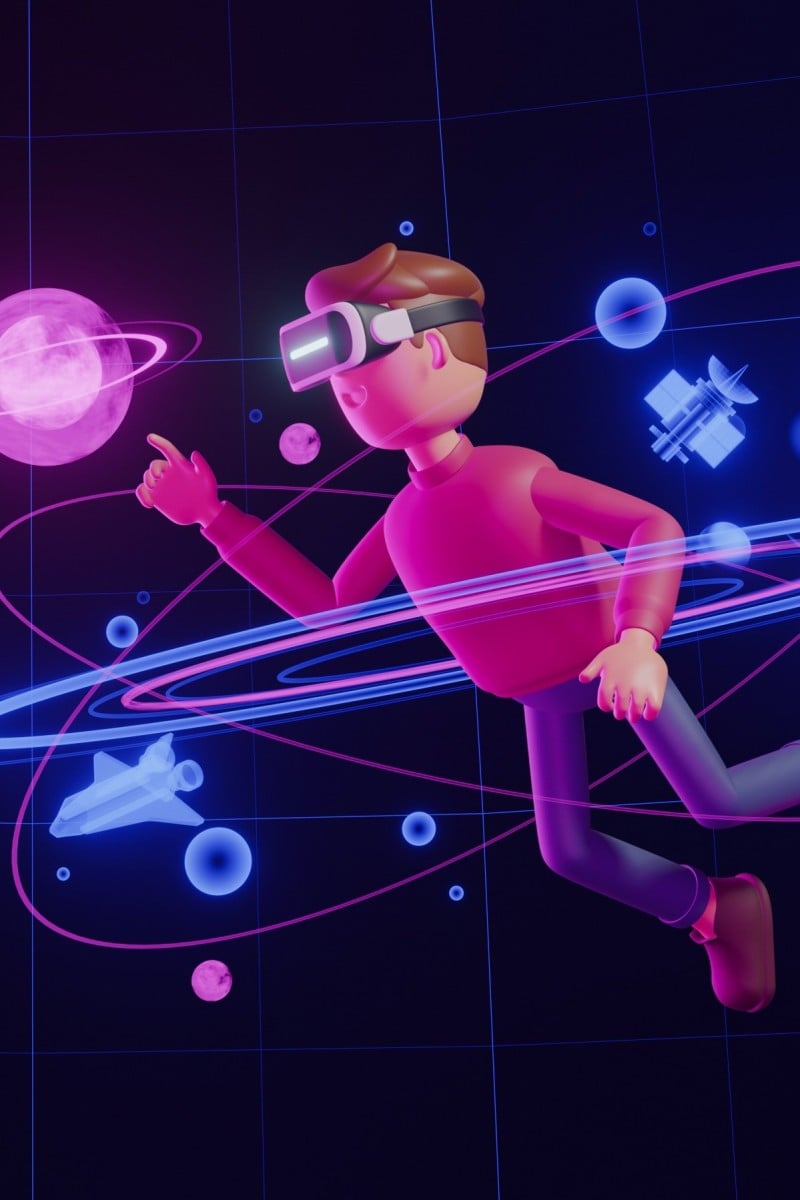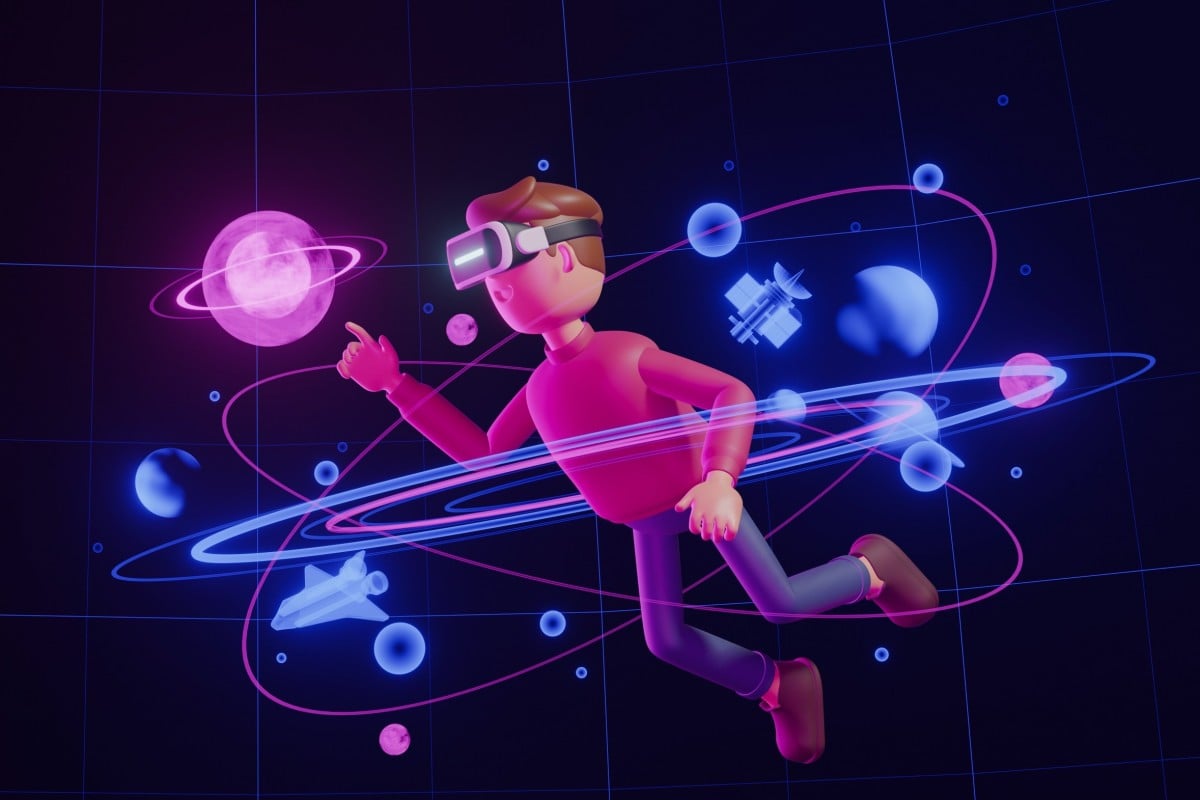
Explainer: 7 metaverse terms to help you understand the future of the internet, from Web3 to play-to-earn games
- Some believe blockchain technology is ushering in the next tech revolution that will completely change how we interact with each other
- To help you figure out what all the fuss is about, we’ve compiled a glossary of phrases related to this topic – decide for yourself if virtual is the new reality
 The metaverse is meant to immerse you in a virtual world that helps you interact with those who aren’t in the same physical space as you. Illustration: Shutterstock
The metaverse is meant to immerse you in a virtual world that helps you interact with those who aren’t in the same physical space as you. Illustration: ShutterstockImagine building a life in a virtual land, roaming around a city and shopping for art with your cryptocurrency wallet – all while wearing a headset in your bedroom.
While many are ready to ride the train to the metaverse, how much do you know about it aside from what you’ve seen in sci-fi films such as Ready Player One and Free Guy?
Here is a glossary of seven metaverse terms that will help you understand what may be the future of the internet.
How would you explain the metaverse to people living before the internet’s existence?
1. What is the metaverse?
The internet has already advanced from being based on text to hosting a range of multimedia, such as games, videos and music. Some people believe the internet’s next step is to evolve into an immersive virtual world powered by artificial intelligence (AI).
The metaverse is a set of 3D virtual spaces where people can socialise, work and play using a digital avatar. It aims to immerse users in virtual reality through sight, touch, sound and even scent.
In the metaverse, you can communicate and interact with people who aren’t in the same physical space as you. Users, businesses and other platforms can exist and interact through digital avatars, advanced virtual reality or augmented reality headsets.
Last October, tech CEO Mark Zuckerberg announced that Facebook’s new name would be Meta, and this was a major move to bring the idea of the metaverse into the mainstream.
According to Zuckerberg, virtual worlds will be so engrossing and convenient that humanity will eventually migrate into the metaverse and leave reality behind.
“Immersive digital worlds [will] become the primary way that we live our lives and spend our time,” he asserted in an interview with podcaster Lex Fridman.
Meta isn’t the only tech giant to invest in building the metaverse – Microsoft, Apple and Google are among the many corporations aiming to build the technology of the future.
However, this term did not come from Zuckerberg or any company in Silicon Valley. In fact, a 1992 science fiction novel Snow Crash by Neal Stephenson introduced a virtual reality successor to the internet, called Metaverse. In the novel, humans use digital avatars of themselves to live in the online world. Now, three decades later, this concept is no longer just a plotline, but a dream for many in the tech world.
Facebook renames itself Meta. Twitter cracks up over its rebrand
2. Avatar
An avatar is your digital identity – it refers to an illustration of a user that will represent you in a computer-generated world. It can be a 2D image like your avatar on Instagram, or a 3D model which is often seen in games or virtual reality.
This term originates from Hindu mythology and refers to the descent of a deity to Earth. In 1985, an American game developer, Richard Garriott, incorporated this concept in the role-playing game Ultima IV: Quest of the Avatar.
In recent years, a number of fashion companies including Prada, Puma and Yoox have incorporated digital avatars into their brands. Currently, there are more than 150 virtual influencers across social media platforms according to Virtual Humans, a website dedicated to tracking this trend.
One of them is Brazilian-American Lil Miquela who was created by tech company Brud and now has 3 million followers on Instagram. In 2018, Time magazine even named her among the 25 Most Influential People on the Internet.
As stated on her Instagram bio, Miquela is a 19-year-old robot living in Los Angeles. She works like many other real-life fashion influencers by, for example, wearing streetwear by Supreme and designer clothes by luxury labels like Chanel and Prada.
Gucci bags for Roblox avatars – crossover between metaverse and real world
3. Creator economy
The creator economy refers to the businesses and people who create and sell content on platforms like Twitch, Instagram, TikTok, YouTube and more. Some people predict that the metaverse will give the creator economy another venue in which to grow.
Around the world, there are more than 50 million independent content creators, curators and community builders. Not only does this include influencers, but it also encompasses vloggers, gamers and podcasters.
Since the pandemic began in 2020, the creator economy has seen huge growth as people have spent more time at home and online. According to a Bloomberg article from August 2021, the creator economy is valued at more than US$20 billion. Influencer Marketing Hub estimated that this could grow to more than US$100 billion in 2022.
4. Decentralisation, DAOs
As a general definition, decentralisation refers to the transfer of control and decision-making power from a central group to a wide network.
For example, in schools, principals and teachers usually make up the central group controlling decisions that affect everyone, from food in canteens to subjects students learn. To decentralise a school, you would spread out the power so everyone, including students, had a say in what happens.
Decentralisation is related to the metaverse because some people believe today’s tech giants – such as Google, Meta, Amazon and Microsoft – should not be the only ones to develop and control the future of the internet.
Decentralised autonomous organisations (DAOs) are different from traditional corporations which are controlled by boards and executives. Instead, a DAO is meant to be controlled by all of its members, who follow a set of rules that are maintained on a blockchain and transparent for everyone to see. DAOs can have any shared mission from collecting NFTs (non-fungible tokens) to predicting the stock market.
To become a member of a DAO, users need to buy its cryptocurrency. Members can then vote on proposals and be involved in decision-making.
Explainer: What are NFTs? Why do they matter to artists?
5. Play-to-earn
When playing most games like Fortnite or Animal Crossing, you buy the game and spend hours – or even months or years – trying to achieve your goal. While you might enjoy playing the game, some believe you should be rewarded for investing time and energy into it.
Play-to-earn games are considered an important part of the metaverse, and they reward players with cryptocurrency or NFTs. Typically, the gaming platform is built on blockchain, and it provides players with a chance to earn in-game tokens that can be sold or exchanged for money in the real world. Some games require you to pay while others are free.
Your Voice: How NFTs might change the world (long letters)
In 2021, play-to-earn games received US$4 billion in investments, according to analytics platform DappRadar.
One example is Axie Infinity, in which users breed and collect cute creatures to explore the game’s world. But hacks are common in the cryptocurrency world, and on March 29, the cryptocurrency network that helps power Axie was hacked for about US$625 million. Also, cryptocurrency tokens usually go up and down in value, meaning players can just as quickly lose money.
6. Sandbox
In the gaming context, a sandbox game, also called a free-roaming game, has no storyline or specific goals for players. Oftentimes, gamers can change the virtual world in the game as much as they want. Popular sandbox games include The Sims, Grand Theft Auto and Minecraft.
An NFT gaming platform called The Sandbox is mixing this open-world gameplay with the metaverse. Users can create art and games that they can monetise through the platform’s cryptocurrency, Sand. They can also purchase virtual land, fashion experiences and concerts.
7. Web3
Web3 ties many of these metaverse concepts together. Proponents say it is the internet’s next step in becoming a decentralised internet and expanding the creator economy.
Packy McCormick, a huge investor in web3, has defined it as “the internet owned by the builders and users, orchestrated with tokens”.
Let’s begin with Web1. Web1 refers to the internet of the 1990s and early 2000s. It was mostly text-based, and information was received passively and statically. Now, Web2, which started around 2005, is driven by social media and user-generated content. People actively engage with the internet, creating and sharing videos, blogs, photos and more.
Some say Web3, built on blockchain, will replace centralised corporate platforms such as Roblox, YouTube and Instagram with community-run networks that have open protocols. This includes DAOs, play-to-earn games and decentralised social media platforms.
Web3’s critics say that today’s most popular blockchains cannot support such complex and massive data systems. Others argue that it is not realistic to believe Web3 can be truly decentralised.
Either way, Web3 and the metaverse are both ideas that have yet to be fully realised. As the technology for them is built, the world will have more time to see if these platforms succeed, or if they crash and burn.
